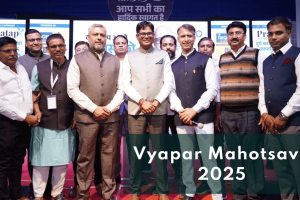Introduction to MSMEs in India
Micro, Small, and Medium Enterprises (MSMEs) are integral to India’s socio-economic fabric. With a 30% GDP contribution and a nearly 50% share in exports, MSMEs provide employment to 60 million individuals across over 28 million enterprises. They dominate the industrial landscape, serving as ancillary units for large industries and producing a wide variety of goods—from traditional handicrafts to high-tech engineering products.
The diversity of this sector extends across eight subgroups, including handlooms, handicrafts, coir, khadi, sericulture, and power looms. This blend of traditional and modern industries makes MSMEs a crucial part of India’s journey towards self-reliance and rural industrialization.
MSMEs’ Contributions to India’s Development
1. Production and Innovation
MSMEs use local raw materials, indigenous skills, and grassroots innovations to develop an extensive range of products. This includes consumer goods like textiles, leather, and processed foods, as well as sophisticated items like medical equipment and components for space missions like Mangalyaan and Chandrayaan.
2. Employment Generation
The labor-intensive nature of MSMEs makes them pivotal for employment, especially in rural areas. By leveraging locally available resources, MSMEs create jobs with minimal capital investment, addressing unemployment and stemming rural-urban migration.
3. Promoting Entrepreneurship
MSMEs empower individuals to channel their entrepreneurial talents into viable businesses. With fewer formalities and lower capital requirements, they serve as incubators for startups and innovation.
4. Export and Global Integration
Indian MSMEs contribute significantly to exports, producing globally recognized items like Darjeeling Tea, Kashmir Pashmina, and Banaras Sarees. They are also increasingly sought after for strategic partnerships due to their innovative capabilities and cost-competitive manufacturing.
Challenges Faced by MSMEs
Despite their pivotal role, MSMEs face several hurdles:
Financial Constraints
Limited access to formal credit systems often forces MSMEs to rely on local moneylenders, leading to financial instability. Banks’ demand for collateral and stringent terms exacerbate these issues, creating a cycle of inadequate working capital and delayed payments.
Raw Material Procurement
MSMEs often struggle with inconsistent availability and high costs of raw materials. Their limited bargaining power and lack of storage facilities further hinder their competitiveness.
Technological Backwardness
The reliance on outdated technology limits productivity and quality, making it difficult for MSMEs to compete globally. Upgrading technology requires significant investment, which many MSMEs cannot afford.
Marketing Challenges
Without robust marketing strategies, MSMEs depend on middlemen, often leading to exploitation. A lack of customer insights and infrastructure makes direct marketing infeasible for many businesses.
Global Competition
Globalization has exposed MSMEs to competition from multinational corporations with superior resources. This competition is particularly intense in export-driven sectors.
Case Studies: Transforming Lives Through MSMEs
Romi Bags (Manipur)
Founded by Khumbongmayum Dhanachandra Singh in 1996, Romi Bags exemplifies how grassroots entrepreneurship can change lives. Using leftover fabrics, Singh developed unique designs that gained national recognition. His success story highlights the resilience, creativity, and impact of MSMEs in empowering individuals and communities.
Space Mission Contributions
MSME Tool Rooms contributed critical components to India’s Chandrayaan and Mangalyaan missions, showcasing the sector’s capability in high-precision manufacturing. Such contributions highlight the sector’s growing importance in advanced industries.
Government Support for MSMEs
MSMED Act, 2006
This act provides a unified legal framework for MSMEs, addressing credit, marketing, and technology challenges. It classifies businesses based on investment and turnover, ensuring targeted support.
| Category | Investment (₹) | Turnover (₹) |
|---|---|---|
| Micro Enterprise | Up to 1 crore | Up to 5 crore |
| Small Enterprise | Up to 10 crore | Up to 50 crore |
| Medium Enterprise | Up to 50 crore | Up to 250 crore |
Skill Development Programs
Programs like Skill India enhance the workforce’s technical and managerial capabilities, enabling MSMEs to adapt to evolving market needs.
Export Assistance and GI Protection
By securing Geographical Indications (GI) for products like Warli Paintings and Kangra Tea, the government ensures international recognition and higher market value.
Future Opportunities and Innovations in MSMEs
Digital Transformation
The adoption of e-commerce platforms and digital tools is enabling MSMEs to reach global markets and improve operational efficiency. Digital India initiatives have further reduced barriers to technology adoption.
Green Manufacturing
Eco-friendly practices and renewable energy adoption will help MSMEs stay competitive in the global market, where sustainability is becoming a key differentiator.
Policy Interventions
Increased access to affordable credit, streamlined regulatory processes, and enhanced infrastructure will provide MSMEs with a solid foundation for growth.
Conclusion: Empowering MSMEs for a Resilient India
The MSME sector is not merely an economic driver but a catalyst for social empowerment and inclusive growth. Addressing the challenges faced by MSMEs while fostering innovation and digital integration will ensure their continued contribution to India’s development. Supporting MSMEs means investing in India’s future—a future where self-reliance and global competitiveness go hand in hand.
For more information or services related to MSMEs in Chhattisgarh:
📧 Email Us:
📞 Call Us:
+91 97551 29633
🌐 Visit Us for Updates:
BharatiyaMedia.com
We’re here to support your entrepreneurial journey!












Add Comment